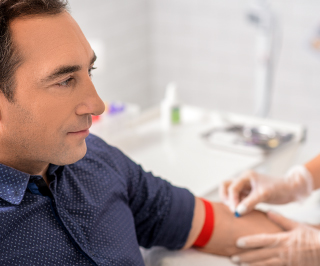
Image credit: YakobchukOlena / iStock / Thinkstock
Multiple blood tests have been the clinical mainstay for confirming type 2 diabetes. However, a study that tracked individuals over several decades for incident diabetes and other conditions found that measuring elevated fasting glucose and HbA1c levels from a single blood sample may suffice for an accurate diagnosis. Investigators published the results of their prospective cohort study in the Annals of Internal Medicine.
Clinicians under current guidelines rely on two glucose tests to confirm a diabetes diagnosis. “Whether 2 different tests from a single blood sample provide adequate confirmation is uncertain,” wrote the study’s investigators, who launched a prospective study known as the Atherosclerosis Risk in Communities (ARIC) trial to see if this approach was possible.
The study enrolled 13,346 participants (12,268 of whom did not have a diagnosis of diabetes) between 1987 and 1989, tracking them over 25 years for incident diabetes and other conditions, including cardiovascular outcomes, kidney disease, and mortality. A single blood sample measuring elevated levels of fasting glucose (≥126 mg/dL) and HbA1c (≥6.5%) was used to confirm and diagnose previously undiagnosed cases of diabetes.
In participants’ second checkup in the early 1990s, the investigators identified 978 individuals who had elevated levels of either fasting glucose or HbA1c. Among these, 595 had just 1 elevated level. And 383 participants had both. For this second cohort, 90% during the study’s initial 15 years were eventually diagnosed with diabetes and were more likely to develop heart disease than those without diabetes or those who had one elevated test result.
Although its sensitivity rate was moderate, at below 55%, study’s confirmatory definition yielded high specificity for identifying cases during the first 5 years of follow-up, eventually increasing to more than 99% specificity over 15 years. Overall, the 15-year positive predictive value was 88.7% and 71.1% for confirmed and unconfirmed cases, respectively.
“The results of our study suggest that the two tests from one blood sample can provide adequate confirmation of diabetes, potentially allowing a major simplification of current clinical practice guidelines,” said study lead author Elizabeth Selvin, PhD, MPH, a professor with Johns Hopkins Bloomberg School of Public Health’s Department of Epidemiology, in a statement.
There are instances in which it would still be appropriate to confirm diabetes with a second blood test, Selvin told CLN Stat. “When the tests are discordant—for example, if the fasting glucose test was above the clinical threshold for diagnosis of diabetes, but the HbA1c was not—it would be appropriate to follow up the patient with a second blood test, consistent with current clinical practice guidelines,” she said.
Selvin and her colleagues hope the results will directly influence clinical practice guidelines for diagnosis of diabetes. “Measuring both HbA1c and fasting glucose in a single blood sample to confirm the patient has diabetes represents a streamlined approach to diagnosis of diabetes and could help ensure that patients get prompt and appropriate care,” she said.
While innovative in its approach, the study is not without its flaws, K.M. Venkat Narayan, MD, MSc, MBA and Ram Jagannathan, PhD wrote in a related editorial. “Most important, the concordance between elevated HbA1c and fasting glucose levels from the single-sample determination was approximately 40% in this study but approximately 70% for repeated measurements of fasting glucose based on conventional criteria. Therefore, the criteria proposed by Selvin and colleagues may miss a large number of persons with diabetes,” they noted.
Narayan and Jagannathan also questioned the investigators’ methods for collecting baseline data after following the participants for several years and measuring glucose at 5-year intervals. “Ideally, an effort to determine whether the diagnostic accuracy of a single-sample 2-test approach approximates that of a repeated test at a subsequent visit would use a confirmatory test within a much shorter period to replicate clinical practice,” they observed.
From a diversity standpoint, they also thought the study’s focus on white and black middle-aged Americans was a bit narrow. “This approach has appeal, especially for resource-challenged settings, but it needs replication in other populations before becoming accepted clinical practice,” Narayan and Jagannathan recommended.